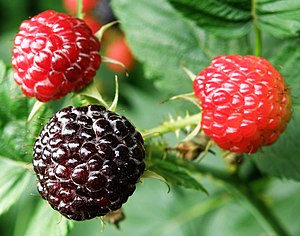Rubus occidentalis
| Black raspberry | ||||||||||||
|---|---|---|---|---|---|---|---|---|---|---|---|---|

Black raspberry ( Rubus occidentalis ) |
||||||||||||
| Systematics | ||||||||||||
|
||||||||||||
| Scientific name | ||||||||||||
| Rubus occidentalis | ||||||||||||
| L. |
The black raspberry ( Rubus occidentalis ) is a Rubus species from the rose family native to eastern North America . It shares its common name black raspberry with the closely related West American Oregon raspberry ( Rubus leucodermis ). Occasionally other names are used such as wild black raspberry , black caps , black cap raspberry , thimbleberry , and scotch cap .
description
Rubus occidentalis is a deciduous shrub 2 to 3 meters high with thorny shoots. The leaves are pinnate ; Each leaf consists of five leaflets on the shoots that grow strongly in the first year and three leaflets on the flowering branches. The flowers consist of long, slender sepals (6–8 mm) that are more than twice as long as the petals . The spherical fruit is a collective fruit of 12 to 15 millimeters in length, which is composed of stone fruits ; it is edible and has high levels of anthocyanins and ellagic acid .
As can be derived from the common name, black raspberries have very dark, purple-black fruits that are colored by the anthocyanin pigments. There are however occasional mutations in the genes encoding anthocyanin production regulate so that yellow fruits variants ( "yellow raspberries", English yellow raspberries ) arise that occasionally by collectors and farm shops in the Midwest (especially in Ohio are marketed) . The yellow-fruited varieties retain the unique taste of the black raspberries, which sets them apart from the similar-looking pale varieties of cultivated red raspberries, generally derived from the Eurasian Rubus idaeus , sometimes the North American Rubus strigosus and other varieties derived from hybrids of these two species.
use
Black raspberries are high in anthocyanins. This helps to use them as a natural coloring agent . Preliminary animal studies to assess their anticancer effects are ongoing and a small-scale clinical study has been performed in patients with Barrett's esophagus .
The center of commercial production of black raspberries in the USA is the Willamette Valley in Oregon . The main variety, "Munger", is grown on around 600 hectares. Other varieties are "John Robertson", "Allen", "Jewel", "Blackhawk", "Macblack", "Plum Farmer", "Dundee", "Hanover" and "Huron". The plants are planted by hand in summer, mechanically pruned in winter and then harvested by machine. The hectare yields are generally low, which is why the fruits are usually expensive.
The species was used to breed many Rubus hybrids; red to black raspberries are mostly marketed as purple raspberries; “Brandywine”, “Royalty” and “Estate” as well as Rubus × neglectus 'Glen Coe' are examples of purple raspberry varieties. Wild purple raspberries have also been found in various locations in northeastern North America where two parent species are common and occasionally hybridize naturally.
The berries are usually dried or frozen, pureed and juiced, or used as coloring . Fresh berries are also marketed seasonally. Well-known liqueurs made from black raspberries include the French Chambord Liqueur Royale de France and various varieties of Bokbunja, a Korean alcoholic drink from South Korea .
Systematics
The black raspberries are closely related to the red-fruited species Rubus idaeus and Rubus strigosus ; they all have the distinctive white underside of the leaves as well as fruits that are easily detached from the carpel when ripe , but the fruits differ in color, which are black in R. occidentalis ; the stems are also thornier. The black fruits give them the appearance of blackberries , although this is only on the surface. The taste is unique and cannot be compared with the red raspberries or blackberries.
Synonyms
The Plant List , a joint venture between the Royal Botanic Gardens (Kew) and the Missouri Botanical Garden , lists the following synonyms:
- Melanobatus michiganus Greene
- Melanobatus occidentalis (L.) Greene
See also
- Dewberry , a group of Rubus species, which is represented as dewberry in Europe with only one species ( Rubus caesius ), but in America is the name for a number of species
- Rubus niveus and Rubus coreanus , related Asian species
- Oregon raspberry , another dark raspberry variety
Individual evidence
- ↑ Rubus occidentalis L. . Global Biodiversity Information Facility. Retrieved April 25, 2019.
- ↑ Taxon: Rubus occidentalis L. . US National Plant Germplasm System. Retrieved January 2, 2018.
- ↑ Michigan Bee Plants: Rubus occidentalis . Retrieved April 25, 2019.
- ↑ NL Britton, A. Brown: An illustrated flora of the Northern United States, Canada and the British possessions from Newfoundland to the parallel of the Southern boundary of Virginia, and from the Atlantic Ocean westward to the 102d meridian . Charles Scribner's Sons, New York 1897.
- ^ Rubus occidentalis . Oklahoma Biological Survey. Retrieved April 25, 2019.
- ↑ Black raspberries show multiple defenses in thwarting cancer . Ohio State University. Archived from the original on April 4, 2007. Retrieved April 26, 2019.
- ↑ Laura A. = Kresty, Wendy L. Frankel, Cynthia D. Hammond, Maureen E. Baird, Jennifer M. Mele, Gary D. Stoner, John J. Fromkes: Transitioning from preclinical to clinical chemopreventive assessments of lyophilized black raspberries: interim results show berries modulate markers of oxidative stress in Barrett's esophagus patients . In: Nutrition and Cancer . 54, No. 1, 2006, pp. 148-156. doi : 10.1207 / s15327914nc5401_15 .
- ↑ Rubus occidentalis L. . The Plant List. Retrieved April 26, 2019.


